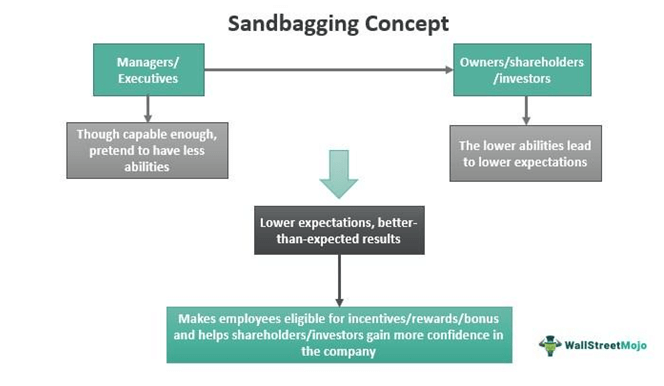Sandbagging is a term not exclusive to business alone, but an old one that emerged in the 1880s. In the past, it was a sly way to attack a person. It derived the name from an act that saw hoodlums fill sags with sand and throw them at unsuspecting passersby, stealing their belongings.
Over time, poker adopted the term, where its more modern definition finds its roots. The idea was the person would deceive their opponent by playing weak or lousy cards while keeping the better cards. The opponent unexpectedly drops their guard and puts in more stakes, believing they would win, only to take a surprising loss.
Today, we have adopted the term in politics, sports like golf, and other industries. This article looks at sandbagging in sales, its purpose, and what to watch for if you plan to do this.
What is Sandbagging in Sales?

Source: WallStreetMojo
Sandbagging itself is to pretend to be weak, only to show your true strength later on. In sales, sandbagging occurs when one deliberately hides relevant information or results from their superior or management to outperform later on.
A sales team’s job is to close a business deal with a lead or prospect. Their training requires them to go after potential customers, turning them into paying customers. To measure how well they perform their duty, they have to meet monthly targets due for review every quarter. Sandbagging is a technique that a sales rep can use to ensure a favorable situation. A good question to ask is why do sales reps sandbag?
The Reasons Sales Representative Sandbag
There are various reasons a sales rep may want to sandbag their sales, and we will discuss some of them in this section.
-
To Exceed Expectation
When a sales rep reports an optimistic chance of closing a high-profile deal, the information is out, and expectations are high to secure it. So instead of telling the superior the actual figure, they report a lower figure to reduce the expectation on that deal.
For example, the sales representative believes they can make between $10,000 and $80,000 on a project based on discussions with a client. They can decide to say $5000 to the superior, knowing that even at the minimum, they will make $10,000. This situation is a win-win for the rep and the company. The seller appears to have outperformed, and the company gets another paying customer.
-
To Divert Attention
If the sales representative is closing down on a vast deal, they can decide to hide this information because of the attention and subsequent pressure to deliver. They may decide it’s best to attend to it without the pressuring eyes of colleagues, their supervisor, or management.
For example, if a sales representative with a quarterly target of $62,000 is closing down on a deal worth $50,000, the pressure to deliver can be massive. The sales rep may report $10,000 to divert others from following closely. In the worst-case scenario, the salesperson can bring in $10,000.
-
To Manage Expectation
While some people use sales sandbagging to exceed expectations and divert attention, others can use it to manage expectations. Using it this way is an ideal technique if you aren’t sure about closing the deal yet. There may be signs of it going through, but it’s too soon to tell, or you aren’t confident landing that lead. If the supervising officer doesn’t know the details, then they can easily manage their expectations.
An example is a sales representative who has been working on a business deal worth $5,000 but isn’t confident about landing it. They may report it as uncertain, and if the deal fails, the rep has already given prior notice. Using sandbagging like this can be helpful for new sales representatives who still don’t know how to gauge a prospect.
While this mindset is one sales personnel rarely possess, it’s a means for some to manage their manager/superior expectation.
-
Build Momentum
A sales rep can decide to delay closing a deal if they have already met their target for the quarter. The sales rep can push it, so it counts towards the beginning of the next quarter. Doing this starts the individual well into the new quarter and can serve as momentum for the sales rep for the next quarter and even year.
Advantages and Disadvantages
As with any other technique in business, there are pros and cons of sandbagging sales. This section will look at some benefits and cons of sandbagging.
Benefits:
-
Impress Management
Impressing their superior is the primary goal of a sales rep. One way of doing this is to exceed expectations regularly. Impressing them allows the employee to attract positive reviews for their performance and win favorable impressions moving forward. One of the many perks of impressing management is better financial compensation.
-
Financial Compensation
This benefit is the reason many sales reps prefer to sandbag their sales. Most times, exceeding performance comes with additional benefits to encourage those who exceeded their expectation and for others to learn from their outstanding colleagues. Those additional benefits may come as added commissions or promotions with better perks.
-
Help to Build Confidence
This advantage is suitable for newbies who need to build some confidence as they grow in their new role in the company. Sandbagging presents the opportunity to make sure that they follow all sales processes correctly. It also ensures they properly plant their feet in the company.
An example is if a sales representative’s quarterly target is $30,000, and they have deals to close worth that amount. The employee may first ensure all sales documents are in order before verifying this information with their superior and formally closing the deals.
Cons:
-
Impact on the Team
Sandbagging sales can be beneficial for a team member, but can be detrimental to the team. This practice can be counterproductive if all or most sales team members practice this technique. It makes the team look ineffective and erratic, two words no team manager wants to hear about their team. Since organizations use past data to plan and budget, uncontrolled and regular sandbagging can makes sales forecast a nightmare.
-
Can potentially lose the Customer
If a client is in a hurry to close a deal, but the sales rep wants to push it to the following week or month, then this may cause them to lose the client to a competitor. Some deals are more urgent than others, so sandbagging can come back to bite the sales representative and the company.
-
Consume Resources
Chasing a lead or prospect consumes company resources, and every physical meeting, call, and emails sent are all costs to the company. When chasing clients, the faster the deal is done, the better for the company. When sandbagging sales, it prolongs the process purposefully to achieve one person’s goal. Such a tactic will cost the company more than it benefits in the long run.
-
Bad Reputation If caught consistently
If a particular individual sandbags sales often, it can lead to a poor reputation from management. Trust issues, warnings, and even termination of employment may be what such an employee is asking for if they continue sandbagging their sales.
-
Taking Precaution When Sandbagging
We perceive sandbagging as a deceitful and manipulative move, and while there is truth to this, it’s possible to regulate sandbagging to get the best from it. This section will look at ways to control and clamp down on it.
-
Monitor Sales Rep using CRM tools
Putting your sales team on a CRM tool and monitoring them can help supervisors and the team leads spot signs of sandbagging and address them privately.
-
Set Rules and Regulation
The best way to combat a sales technique like sandbagging is to leave no grey area. Explicitly explaining the dos and don’ts will help team members stay on their toes. If management perfectly spelled every action out, it’s easier to punish those who go against the set rules. Some rules can detail at what point a sales rep should consider a prospect an actual sell, and when to hold on.
The sales team leader may also outright ban some sandbagging practices, like withholding all forms of information regarding the progress of leads. Having rules in place makes it easier for everyone to work together for the best of the team and the organization at large.
Final Words
In conclusion, sandbagging sales or not is a decision left to the management. There are clear advantages, but team leads and supervisors should beware of the potential dangers. Understanding sandbagging’s meaning and its consequences on both the team and company is essential to deciding whether it’s worth controlling the practice or outright banning it.






